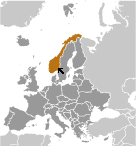World Atlas: Norway. On this page you can see the map, country flag and many detailed information about the people, history and economy of Norway.

Here you can find online selected information about the geography, inhabitants, government, economy and history of Norway. Included are selected statistics, an overview map and the detailed map of Norway. But let's start with the flag of Norway here:
Norway - Overview:
What you should know about Norway? Let's start with this: Two centuries of Viking raids into Europe tapered off following the adoption of Christianity by King Olav Tryggvason in 994; conversion of the Norwegian kingdom occurred over the next several decades. In 1397, Norway was absorbed into a union with Denmark that lasted more than four centuries. In 1814, Norwegians resisted the cession of their country to Sweden and adopted a new constitution. Sweden then invaded Norway but agreed to let Norway keep its constitution in return for accepting the union under a Swedish king. Rising nationalism throughout the 19th century led to a 1905 referendum granting Norway independence. Although Norway remained neutral in World War I, it suffered heavy losses to its shipping. Norway proclaimed its neutrality at the outset of World War II, but was nonetheless occupied for five years by Nazi Germany (1940-45). In 1949, Norway abandoned neutrality and became a member of NATO. Discovery of oil and gas in adjacent waters in the late 1960s boosted Norway's economic fortunes. In referenda held in 1972 and 1994, Norway rejected joining the EU. Key domestic issues include immigration and integration of ethnic minorities, maintaining the country's extensive social safety net with an aging population, and preserving economic competitiveness.
Geography of Norway
 Where on the globe is Norway? The location of this country is Northern Europe, bordering the North Sea and the North Atlantic Ocean, west of Sweden. Total area of Norway is 323,802 sq km, of which 304,282 sq km is land. So this is quite a large country. How could we describe the terrain of the country? This way: glaciated; mostly high plateaus and rugged mountains broken by fertile valleys; small, scattered plains; coastline deeply indented by fjords; arctic tundra in north. The lowest point of Norway is Norwegian Sea 0 m, the highest point Galdhopiggen 2,469 m. And the climate is temperate along coast, modified by North Atlantic Current; colder interior with increased precipitation and colder summers; rainy year-round on west coast.
Where on the globe is Norway? The location of this country is Northern Europe, bordering the North Sea and the North Atlantic Ocean, west of Sweden. Total area of Norway is 323,802 sq km, of which 304,282 sq km is land. So this is quite a large country. How could we describe the terrain of the country? This way: glaciated; mostly high plateaus and rugged mountains broken by fertile valleys; small, scattered plains; coastline deeply indented by fjords; arctic tundra in north. The lowest point of Norway is Norwegian Sea 0 m, the highest point Galdhopiggen 2,469 m. And the climate is temperate along coast, modified by North Atlantic Current; colder interior with increased precipitation and colder summers; rainy year-round on west coast.
Inhabitants of Norway
Let's take a look how many people live in Norway. The number is: 5,320,045 (July 2017 est.). So this is not very populous country. Who lives here? Norwegian 83.2% (includes about 60,000 Sami), other European 8.3%, other 8.5% (2017 est.). What are the languages in Norway? Bokmal Norwegian (official), Nynorsk Norwegian (official), small Sami- and Finnish-speaking minorities. And the religions: Church of Norway (Evangelical Lutheran - official) 71.5%, Roman Catholic 2.8%, other Christian 3.9%, Muslim 2.8%, other 2%, unspecified 7.5% (2016 est.). How old are the people in average? 39.2 years. We have to add that this number is the median - so one half of the people is older than this, one half is younger. And what is their life expectancy (at birth)? This: 81.9 years. Where the people live in Norway? Here: most Norweigans live in the south where the climate is milder and there is better connectivity to mainland Europe; population clusters are found all along the North Sea coast in the southwest, and Skaggerak in the southeast; the interior areas of the north remain sparsely populated. The major urban areas of Norway are: OSLO (capital) 986,000 (2015).
Government and Economy of Norway
The capital of Norway is Oslo and the government type parliamentary constitutional monarchy. Let's take a look at the administrative divisions - 19 counties (fylker, singular - fylke); Akershus, Aust-Agder, Buskerud, Finnmark, Hedmark, Hordaland, More og Romsdal, Nordland, Nord-Trondelag, Oppland, Oslo, Ostfold, Rogaland, Sogn og Fjordane, Sor-Trondelag, Telemark, Troms, Vest-Agder, Vestfold. Regarding the economy of Norway, important industrial products are petroleum and gas, shipping, fishing, aquaculture, food processing, shipbuilding, pulp and paper products, metals, chemicals, timber, mining, textiles. Important agricultural products are barley, wheat, potatoes; pork, beef, veal, milk; fish. The most important export commodities are petroleum and petroleum products, machinery and equipment, metals, chemicals, ships, fish and the most important export partners are UK 21%, Germany 14.4%, Netherlands 10.7%, France 6.9%, Sweden 6.5%, Belgium 4.4%, US 4.3%, Denmark 4% (2016). The most important import commodities are machinery and equipment, chemicals, metals, foodstuffs and the most important import partners are Germany 12.2%, Sweden 12.2%, China 11.2%, US 6.6%, Denmark 5.7%, UK 5.2%, Netherlands 4.1% (2016). How rich is Norway and how rich are people in this country? The most important number here is GDP per capita (PPP): $70,600 (2017 est.). This means the people are rich on average here. Let's add that this means Gross Domestic Product per person, which is recalculated with respect to the relative cost of local goods and services. And one more important number - population below poverty line: NA%.